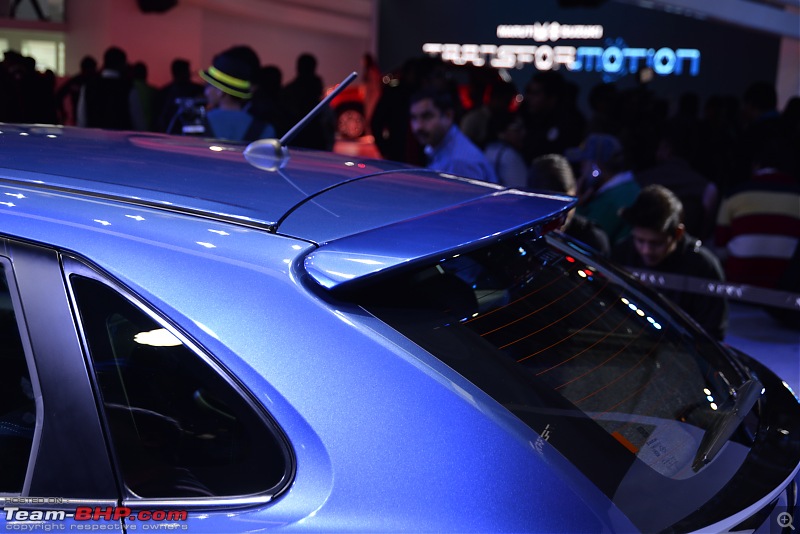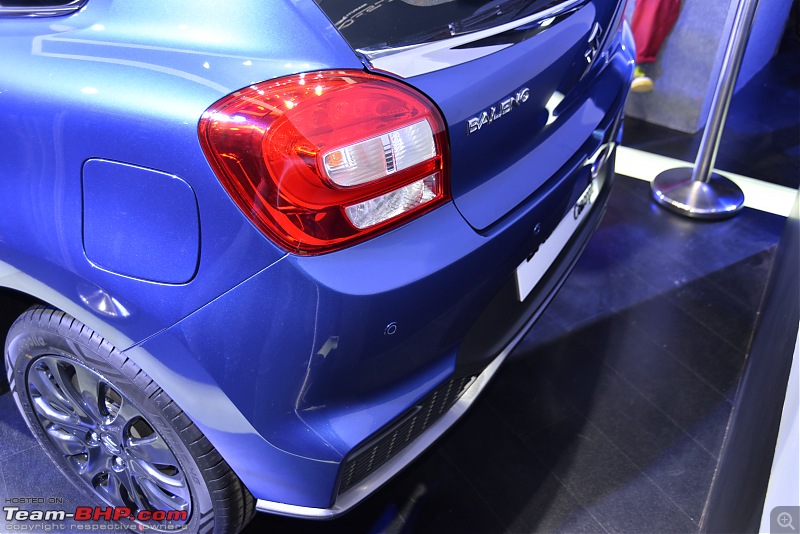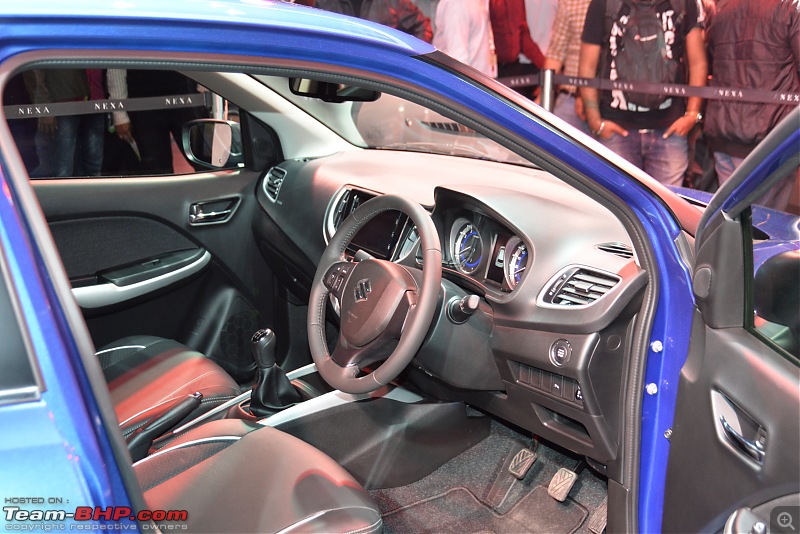Team-BHP
(
https://www.team-bhp.com/forum/)
Mod Note: Our Baleno RS Review has been taken live at this link. Please continue the discussion over on the new thread. Thanks! Edit on 5th February 2016
Our original scoop had more information than what Maruti shared at the Auto Expo :D. Plus, the discussion was informative, hence continuing in the same thread. Thanks to Vid6639 for these pictures!
The 1.0L turbo-petrol project is a go! Maruti says that the launch will happen in the festival season (i.e. Diwali):

The Boosterjet engine has 3 cylinders and a turbocharger. It develops 110 BHP and 170 Nm of torque. More powerful yes, but the 3-cylinder won't be as quiet, nice sounding or refined as the regular 1.2L 4-cylinder engine:

Sportier body kit includes a new bumper, tighter lower air-dam, foglamp housing & skirts. The radiator grille pattern has changed too. Would look so much better if that long V-shaped chrome strip was in black:

Other than the skirts & blackened rims (same design as stock), not much has changed on the side:

Zooming in:

Because the Baleno is well-priced, we hope that the RS variant is also priced in a tempting manner. @ Maruti, charge a premium, but keep it real. Don't do an 'S-Cross 1.6':

Same spoiler as the stock car:

New rear bumper & skirting too:

Yes! Those are rear disc brakes:

Other than the seat upholstery, the cabin doesn't seem to have any changes. A big draw for enthusiasts will be that 5-speed MT gear lever & 3 pedals (Polo GT TSI only available with an AT). We can expect some more equipment from the RS when it goes into production:
 Original Post from 28th December 2015 below:
Original Post from 28th December 2015 below:
Thank you to
Naren Konamme for sharing these pictures and information with other enthusiasts!
Maruti Suzuki has started testing a more powerful version of the Baleno hatchback. The car was spotted at a hotel parking lot in Cochin. Naren spoke to the team of Maruti engineers who were staying in the same hotel and got some information about the car.
The car was spotted in black colour. It might be noted that the Baleno isn't sold in black at present.
The Baleno under test was powered by a 1-litre Boosterjet engine. At present the Baleno is available with only one petrol engine in India - a 1.2-litre, 4-cylinder unit that puts out 83 BHP and 115 Nm of torque. The Boosterjet engine has 3 cylinders and a turbocharger. It develops 110 BHP and 170 Nm of torque. Naren claims that the engine sound was a little more compared to his new petrol Baleno.
The Baleno Boosterjet was being benchmarked against the Volkswagen Polo GT TSI and both cars were being driven back to back. The Baleno had a 5-speed manual transmission (the Polo is only available with a 7-speed automatic).
The car under test was an export model and had additional safety features such as side airbags, all four disc brakes, tyre pressure monitoring system and radar-based brake support (which was showing as disabled in the MID).
The body panels and doors felt the same as the Indian Baleno. When he asked whether the body shell is the same for the Indian and export models, the engineer replied in the affirmative. The alloy wheels were different and looked a lot better than the ones found on the existing car. The kerb weight of the car is about of 950 kg (regular Baleno weighs 865 kg).
Coming to the interiors, the seat fabric etc. were the same as the regular Baleno.
Maruti is testing the Baleno Boosterjet in various parts of India. Cochin was chosen for its coastal climate. The car is likely to be launched India in mid or late 2016.
Naren was not allowed to click interior shots of the car. However, he did manage to get a couple of exterior shots.

Autocar UK had mentioned the Baleno Boosterjet engine supposedly does a 0-100 in approx 10.5 sec. in their review. Will definitely look forward to more concrete information on the same.
I don't get what is it with reduced cylinders and less displacement with Maruti. Can't they use a larger displacement, such as 1.2L petrol and 4 cylinders and also add a turbo to achieve a bigger BHP and torque figure while also keeping the noise levels down?
While the engine noise is good to hear when we floor the pedals, always having to listen to the strong note even while running on low RPMs result in passengers getting tired actually.
These were the same folks who used 800cc 2 cylinder engine on Celerio Diesel that costs roughly 6.75 lakhs!
Looking ahead if the value for money proposition that Baleno have now could be there in the boosted avatar. I was aiming for petrol Alpha and now I am gonna sit on the bench and watch!
Quote:
Originally Posted by Gosu
(Post 3879184)
Autocar UK had mentioned the Baleno Boosterjet engine supposedly does a 0-100 in approx 10.5 sec. in their review. Will definitely look forward to more concrete information on the same.
|
The Euro spec Baleno has the engine mated to a 6 speed gear box, also the figure was speculated and not tested officially by Autocar UK. Suzuki also didn't reveal the official 0-100 timings
The 6 speed AT combined with Baleno's light weight might actually make it faster, though it is not possible with MT
Quote:
Originally Posted by Aditya
(Post 3879128)
When he asked whether the body shell is the same for the Indian and export models, the engineer replied in the affirmative
|
Quote:
Originally Posted by Aditya
(Post 3879128)
The kerb weight of the car is about of 950 kg (regular Baleno weighs 865 kg).
|
Weight difference of 85Kgs can't be because of 1L boosterjet engine or additional features. There would be components for additional structural rigidity for this export spec model (as was with Euro spec Swift).
Here are the specs of the Baleno - Boosterjet and summary report as tested on Spanish roads! An impressive mileage figures at 22 km/L
Quote:
The 1.0 direct injection with turbocharger: the power of 111 horses is remarkable for the displacement, as well as the maximum torque of 170 Nm. It is a very efficient engine, as well as low-noise in all conditions of use, and that makes the car very brilliant without weighing too much on fuel consumption. The figures speak for approval of an average distance of 22.2 km / liter, with CO2 emissions of 103 g / km; in our tests (according to information from the trip computer) we stopped at 18 km / l, a more than good, got a careless driving consumption. Shooting it seemed ready, also because of the reduced mass of the new platform (the house does not represent the time required for the "0-100"), and the top speed (200 times), it seemed entirely within the reach of Suzuki Baleno. In terms of dynamism, the car performed really well. The suspension is well tuned: a good compromise, which allows you to switch over potholes without too many bumps, without conceding too much to roll during cornering. The gearbox, five-speed manual, is quite accurate, but the steering is what we liked even more: not too geared down, always allows good control of the car. Finally, a note about security: adaptive cruise control maintains a selected distance to the vehicle ahead.
|
 http://www.alvolante.it/primo_contat...baleno-10-dict
http://www.alvolante.it/primo_contat...baleno-10-dict
Usually three cylinders don't give as refined an experience as four. Just wondering why they have chosen a three cylinder engine for this one. I would have really waited for this one had I come to know about this at least three days earlier than I actually did.
Quote:
Originally Posted by hybridpetrol
(Post 3879189)
I don't get what is it with reduced cylinders and less displacement with Maruti. Can't they use a larger displacement, such as 1.2L petrol and 4 cylinders and also add a turbo to achieve a bigger BHP and torque figure while also keeping the noise levels down?
|
Quote:
Originally Posted by ajayc123
(Post 3879331)
Usually three cylinders don't give as refined an experience as four. Just wondering why the moy have chosen a three cylinder engine for this one.
|
Well the smaller engines, like the BoosterJets from Suzuki and the EcoBoost family from Ford, promise to deliver the power of bigger displacement engines with the fuel efficiency of the smaller ones.
They are able to do so by using turbos and direct injection. While turbos feed more air to the engines and makes torque available from a lower rpm, direct injection cuts out the process of intake tract to inject fuel. In simpler terms, it is a less complicated and more efficient form of fuel injection resulting in higher power and lesser consumption of fuel.
Keeping the number of cylinders less, helps in achieving better FE.
For eg.
Ford EcoSport -
Regular - 1.5 L / 4 Cyl. / 112 PS / 140 NM@4400 rpm
vs
EcoBoost -1.0 L / 3 Cyl. / 125 PS / 170 NM@1400-4500 rpm
Ford Mustang (Sold outside)
Regular - 3.7 L / 6 Cyl. / 300 HP / 380 NM
vs
Ecoboost - 2.3 L / 4 Cyl. / 310 HP / 433 NM
Ford Explorer (Sold Outside)
Regular - 3.5 L / 6 Cyl. / 290 HP / 345 NM
vs
Ecoboost - 3.5 L / 6 Cyl. / 365 HP / 475 NM
Thats the advantage Maruti wants to bring to India.
Baleno
Regular - 1.2 L / 4 Cyl. / 84 PS / 115 NM
vs
BoosterJet - 1.0 L / 3 Cyl. / 110 PS / 170 NM
Quote:
Originally Posted by hybridpetrol
(Post 3879189)
These were the same folks who used 800cc 2 cylinder engine on Celerio Diesel that costs roughly 6.75 lakhs!
|
The same reasoning mentioned above is not applicable here, as there is no such technology used in the 2 cylinder diesel engine in Celerio. This is a simple case of lesser displacement, lesser power and more FE.
Quote:
Originally Posted by volkman10
(Post 3879251)
Here are the specs of the Baleno - Boosterjet and summary report as tested on Spanish roads! An impressive mileage figures at 22 km/L
|
Seriously
volkman10, those are very impressive FE numbers. Whats all the more enticing to an end user in India, is the 'Maruti' badge behind that :thumbs up
Following are the numbers vis-a-vis its only competition, if launched in India:
Polo GT TSI
Power - 105 bhp
Torque - 175 NM
Bhp/ton - 91
NM/Ton - 154
Baleno Boosterjet
Power - 111 bhp
Torque - 170 NM
Bhp/ton - 110
NM/Ton - 169
It is a given that no human can probably shift gears like a DSG gearbox. Considering this fact, Baleno Boosterjet may just end up few tenths of a second faster than the GT TSi.
But what is quite impressive is the top whack of 200 !! :Shockked:
I would be interested to know if the boosterjet still retains traditional japanese traits of easy mod-ability. Is the block strong enough and reliable to take the pressure of performance modifications or is it like every other micro displacement forced induction motor which is already performing just a safe buffer away from its limit
Quote:
Originally Posted by mayank0782
(Post 3879410)
Well the smaller engines, like the BoosterJets from Suzuki and the EcoBoost family from Ford, promise to deliver the power of bigger displacement engines with the fuel efficiency of the smaller ones.
|
Thanks for the comparison figures!
Turbos are the way of future as they can help provide more power with less displacement. Due to environmental concerns, the displacement has to be less and engines have to be more efficient. The side effect of this increased efficiency at lesser displacement and less number of cylinders is the raised NVH levels.
To play a part in being environment friendly, car buyers will now have to pay for additional components, such as turbo and its components, costs associated with technology and royalties related to this, and also the dampeners, linen fabric etc to contain the NVH levels. I really come to a conclusion myself whether paying extra for the turbo is worth it or not! :)
Small turbo-petrol, AMT, SHVS, explosive 1.6L diesel (S-Cross), and there's more to come. Personally, I'm glad that Suzuki's R&D department has actually started working after so many years of technological complacence.
As they say, if you want to popularise a new technology, no better choice than the market leader to do it.
110 horses should make the Baleno quite a sprinter. However, I'm sceptical about the turbo-lag. Saw it in the EcoSport 1.0L turbo and it wasn't enjoyable at low rpms. I've owned a Civic for many years and trust me, a car with poor bottom end torque can be a pain in the city. Which is why, my favourite engine for the EcoSport is the 1.5L diesel (and not the much-hyped 1.0L EcoBoost).
Quote:
Originally Posted by GTO
(Post 3879556)
110 horses should make the Baleno quite a sprinter. However, I'm sceptical about the turbo-lag.
|
Not sure about the lag in the 1L Turbo engine by Suzuki, but the 1.4L Boosterjet Turbo engine in international Vitara is acclaimed for its linear power delivery.
Instead of adding turbo to the 1L engine, they should have added it to to the 1.2L 4-cyl engine, and produce around 120BHP.
BTW, how much is the cost difference between a non-turbo and a turbo engine (with small displacements)?
Quote:
Originally Posted by volkman10
(Post 3879581)
It will not be cost effective considering the boosterjet is imported. S Cross is rumored to get the 1.4L Engine from Ciaz.
|
What about the 1.5L engine that was rumored to be coming to India?
It'd be interesting to see if Maruti could plonk this engine under the hood of the S-Cross as well. Granted it won't be a sprinter, but it'd certainly be a better bet than the 1.4 NA petrol engine from the Ertiga/Ciaz.
I think the S-Cross needs a Petrol option real quick in the current auto market. This engine could be the key.
| All times are GMT +5.5. The time now is 19:27. | |













